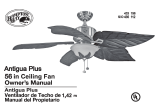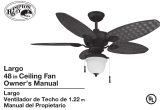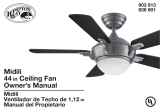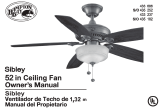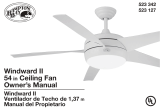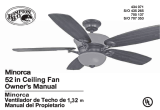Page is loading ...

P250008
93099671_A

Limited Lifetime
Warranty
Progress Lighting fan motors are warranted to the original purchaser to be free of electrical and/
or mechanical defects for so long as the original purchaser owns the fan. Pull chain switches, reverse
switches, capacitors and metal nishes are warranted to be free from defects in materials or workmanship
for a period of 1 year from the date of purchase. Warping of wooden or plastic blades is not covered by
this warranty nor is corrosion and/ or deterioration of any nishes for fans installed within ten miles of
any sea coast. Extended warranties for ENERGY STAR® qualied products may apply.
Progress Lighting ceiling fans with built-in LED light sources, when properly installed and under normal
conditions of use, are warranted to be free from defects in material and workmanship which cause the
light sources to fail to operate in accordance with the specications for (i) ve (5) years from the date of
purchase on the LED Light modules and electrical components for fans used in single family residences,
and (ii) three (3) years from the date of purchase on the LED Light modules and electrical components
for fans used in multi-family or commercial applications. LED bulbs supplied by Progress Lighting carry
no warranty other than manufacturer’s warranty. Non-LED bulbs carry no warranty.
With proof of purchase, the original purchaser may return the defective fan to the place of purchase
during the rst 30 days for replacement. After 30 days, the original purchaser MUST contact Progress
Lighting at (864) 678-1000 for repair or replacement which shall be determined in Progress Lighting’s
sole discretion and shall be purchaser’s sole and exclusive remedy.
Labor and Shipping Excluded. This warranty does not cover any costs or fees associated with the labor
(including, but not limited to, electrician’s fees) required to install, remove, or replace a fan or any fan
parts.
This warranty shall not apply to any loss or damage resulting from (i) normal wear and tear or alteration,
misuse, abuse or neglect, or (ii) improper installation, operation, repair or maintenance by original
purchaser or a third party, including without limitation improper voltage supply or power surge, use of
improper parts or
accessories, unauthorized repair (made or attempted) or failure to provide maintenance to the fan.
THE FOREGOING WARRANTIES STATE PROGRESS LIGHTING’S ENTIRE WARRANTY
OBLIGATION AND ORIGINAL PURCHASER’S SOLE AND EXCLUSIVE REMEDY RELATED
TO SUCH PRODUCTS. PROGRESS LIGHTING IS NOT RESPONSIBLE FOR DAMAGES
(INCLUDING INDIRECT, SPECIAL, INCIDENTIAL OR CONSEQUENTIAL), DUE TO PRODUCT
FAILURE, WHETHER ARISING OUT OF BREACH OF WARRANTY, BREACH OF CONTRACT,
OR OTHERWISE. THIS WARRANTY IS GIVEN IN LIEU OF ALL OTHER WARRANTIES,
WHETHER EXPRESSED OR IMPLIED, INCLUDING THOSE OF MERCHANTABILITY, FITNESS
FOR A PARTICULAR PURPOSE OR NONINFRINGEMENT.
Some states do not allow limitations on how long an implied warranty lasts or the exclusion or limitations
of incidental or consequential damages, so the above limitations and exclusions may not apply to you.
This warranty gives you specic rights and you may have other rights which vary from state to state.
Date Purchased
Store Purchased
UL Model No.
Serial No.
Vendor No.
UPC
Lifetime Limited
Warranty
111017
785247230532, 785247230525,
785247230549

1
2
3
10
11
11
12
Safety Rules
Unpacking
Y
our Fan
Installing Your Fan
Operating Your Fan
Care of Your Fan
Troubleshooting
Specications
Table of Contents

1.
To reduce the risk of electric shock, insure electricity
has been turned of
f at the circuit breaker or fuse box
before beginning.
2.
All wiring must be in accordance with the National
Electrical Code ANSI/NFP
A 70-1999 and local electrical codes.
Electrical installation should be performed by a
qualied licensed electrician.
3.
CAUTION: T
o reduce the risk of personal injury, use only
the screws provided with the electrical box.
4.
The outlet box and support structure must be securely
mounted and capable of reliably supporting 35 lbs. (15.9
kg). Use only UL Listed outlet boxes marked “Acceptable
for Fan Support of 35 lbs. (15.9 kg) or less.”
5.
The fan must be mounted with a minimum of 7 feet
clearance from the trailing edge of the blades to the oor
.
6. Do not operate reversing switch while fan blades are in
motion. Fan must be turned of
f and blades stopped before
reversing blade direction.
7.
Avoid placing objects in path of the blades.
8. To avoid personal injury or damage to the fan and other
items, be cautious when working around or
cleaning the fan.
9.
Do not use water or detergents when cleaning the fan or fan
blades. A dry dust cloth or lightly dampened cloth will be
suitable for most cleaning.
10.
After making electrical connections, spliced conductors
should be turned upward and pushed carefully up into
electrical box.
The wires should be spread apart with the
grounded conductor and the equipment-grounding
conductor on one side of the electrical box and ungrounded
conductor on the other side of the electrical box.
11.
Electrical diagrams are for reference only. Light kits that
are not packed with the fan must be UL Listed and marked
suitable for use with the model fan you are installing.
Switches must be UL General Use Switches. Refer to the
instructions packaged with the light kits and switches for
proper assembly.
12. All set screws must be checked and retightened where
necessary before installation.
1. Safety Rules
READ AND SA
VE THESE INSTRUCTIONS
TO
REDUCE THE RISK OF FIRE, ELECTRIC SHOCK OR PERSONAL
INJURY, MOUNT TO OUTLET BOX MARKED “ACCEPTABLE FOR FAN
SUPPORT OF 35LBS. (15.9 KG) OR LESS”, AND USE SCREWS PRO-
VIDED WITH THE OUTLET BOX.
TO REDUCE
THE RISK OF PERSONAL INJURY, DO NOT BEND THE
BLADE BRACKETS (ALSO REFERRED TO AS (“FLANGES”) DURING
ASSEMBLY OR AFTER INSTALLATION. DO NOT INSERT OBJECTS IN
THE PATH OF THE BLADES.
TO
REDUCE THE RISK OF SHOCK, THIS FAN MUST BE INSTALLED
WITH AN ISOLATION CONTROL/SWITCH.

1
2
3
4
5
6
7
8
a. Blade attachment hardware
(13 screws)
b. Mounting hardware
(1 blade bracket screw)
c. Electrical hardware & Balancing kit
(3 plastic wire nut connectors, 1 pull
chain and blade balancing kit)
d. Mounting hardware
(1 rubber gasket)
5. Fan Motor Assembly
6. Blade
Arms (4)
7. Blades (4)
8. Switch Housing
1. Mounting Bracket (inside canopy)
2. 6” Ball/Downrod Assembly (hanger pin
and locking pin pre-attached)
3. Canopy with Canopy Ring (attached)
4. Decorative Motor Collar Cover
2. Unpacking Y
our Fan
Unpack your fan and check the contents. Y
ou should have the following items:
a
b
c d

3. Installing Y
our Fan
Tools Requir
ed
Phillips screw driver or straight slotted screw
driver
, adjustable wrench, step ladder, and
wire cutters.
Mounting Options
If there isn’t an existing electrical box, then
read the following instructions. Disconnect
the power by removing fuses or turning off
circuit breakers.
Secure the electrical box directly to the building
structure. Use appropriate fasteners and
building materials. The electrical box and
its support must be able to fully support the
moving weight of the fan (at least 35 lbs.).
Do not use plastic electrical boxes.
Figures 1, 2, and 3 are examples of different
ways to mount the electrical box.
Note: Y
ou may need a longer downrod to
maintain proper blade clearance when
installing on a steep, sloped ceiling. The
maximum angle allowable is 30˚. If the
canopy touches downrod, remove the
decorative canopy bottom cover and turn
the canopy 180˚ before attaching the canopy
to the mounting bracket.
To hang your fan where there
is an existing
xture but no ceiling joist, you may need an
installation hanger bar as shown in Figure 4.
TO REDUCE THE RISK OF FIRE, ELECTRIC
SHOCK
OR PERSONAL INJURY, MOUNT
TO OUTLET BOX MARKED “ACCEPTABLE
FOR FAN SUPPORT OF 35LBS. (15.9 KG) OR
LESS”, AND USE SCREWS PROVIDED WITH
THE OUTLET BOX. ELECTRICAL BOXES
COMMONLY USED FOR THE SUPPORT OF
LIGHTING FIXTURES MAY NOT BE ACCEPT-
ABLE FOR FAN SUPPORT AND MAY NEED TO
BE REPLACED. CONSULT A QUALIFIED ELEC-
TRICIAN IF IN DOUBT.
Figure 1
Figure 2
Figure 4
Figure 3

4.
Hanging the Fan
REMEMBER
to turn off the power
. Follow
the steps below to hang your fan properly.
NOTE: This fan is recommended for
standard ceiling mount using the downrod
provided with this fan. When using standard
ceiling installation with the 6 inch downrod
provided, the distance from the ceiling
to the bottom of the fan blades will be
approximately 12 inches.
Standard Ceiling Mounting
1. Remove the canopy ring from the canopy
by turning the ring clockwise until it
unlocks. (Figure 5)
2. Remove the mounting bracket from the
canopy by loosening the four screws on
the top of the canopy
. Remove the two
non-slotted screws and loosen the slotted
screws. This will enable you to remove
the mounting bracket. (Figure 6)
4. Remove the hanger pin and locking pin
from downrod assembly.
5. Route the wires exiting the top of the fan
motor through the decorative motor collar
cover then the canopy ring. Make sure the
slot openings are on top. Route the wires
through the canopy and then through the
ball/downrod assembly
. (Figure 7)
Remove
Loosen but Do Not Remove
Turn Canopy Ring to Remove
Figure 5
Figure 6
6. Loosen, but do not remove, the set screws
on the collar on the top of the motor
housing.
7. Align the holes at the bottom of the
downrod with the holes in the collar on top
of the motor housing. (Figure 7)
Carefully insert the hanger pin through the
holes in the collar and downrod. Be careful
not to jam the hanger pin against the wiring
inside the downrod. Insert the locking pin
through the hole near the end of the b
o
lt
until it snaps into its locked position, as
noted in the circle inset of Figure 7.
8. Re-tighten the set screws on the collar on
top of the motor housing.
9. Make sure the grommet is properly installed
in the collar cover
, then slide the collar cover
on the downrod until it rests on the motor
housing. Be sure that the canopy and the
collar cover are both oriented correctly.
10. Proceed to “Installing the Fan” section.
FAILURE T
O PROPERLY INSTALL SET SCREWS
AS NOTED IN STEP 8 COULD RESULT IN FAN
LOOSENING AND POSSIBLY FALLING.
Figure 7
Tighten
Screw
Locking
Pin
Motor Wires
Ball/Downrod
Assembly
Ceiling
Canopy
Canopy
Ring
Motor Collar
Cover
Hanger
Pin
Motor Collar
Pin in Locked
position

5.
Close-to-Ceiling
Mounting
1. Remove the canopy ring from the canopy
by turning the ring to the right until it locks.
(Figure 5)
2. Remove the mounting plate from the canopy
by loosening the four screws on top of the
canopy. Remove the two non-slotted screws
and loosen the slotted screws. This will
enable you to remove the mounting plate.
(Figure 6)
3. Remove the decorative canopy bottom cover
from the canopy by depressing the three
4. Remove three of the six screws and lock
washers (every other one) securing the
motor collar to the top of the fan-motor
assembly. (Figure 9)
5. Route the wires exiting the top of the fan-
motor assembly through the rubber gasket
aligning the holes in the rubber gasket with
the three screw holes in the fan-motor
assembly
.
6. Route the wires exiting the top of the fan-
motor assembly through the canopy ring,
and the canopy (make sure the slot openings
for the canopy ring and canopy are on top).
Place the canopy over the collar at the top of
the motor. (Figure 10)
7. Align the mounting holes in the canopy
with the screw holes in the motor and fasten
using the three screws and lock washers
(removed previously).
Tighten the mounting
screws securely
.
Canopy
Bottom Cover
Screw and
Lockwasher
(3 of 6 places)
Motor
Collar
Figure 8
Figure 9
Figure 10
studs. (Figure 8)

If using close-to-ceiling mounting, hang the
(Figure 12a)
bracket aligned with the slot in the ball.
until it is seated with the tab of the mounting
bracket.
assembly into the socket of the mounting
the mounting bracket.
center hole in the mounting bracket.
face toward the outlet box, as shown.
at side of the mounting bracket should
washers (not included) between the
box by using the two screws provided with
Install the mounting bracket on the outlet
Installing Fan to
the Electrical Box
WHEN MOUNTING THE FAN ON
A SLOPED
CEILING, THE STANDARD BALL/DOWNROD
MOUNTING METHOD MUST BE USED. THE
MOUNTING BRACKET MUST BE MOUNTED
SO THAT THE SLOT OPENINGS ARE ON THE
LOWER SIDE BY SLIDING THE MOUNTING
BRACKET FROM THE TOP DOWN.
1. Pass the 120-Volt supply wires through the
(Figure 1
1)
2.
the outlet box. If necessary, use leveling
mounting bracket and the outlet box.
The
(Figure 11)
3. Securely tighten the two mounting screws.
Figure 11
Washers
120V
Wires
UL Listed
Electrical
Box
Ceiling
Mounting
Bracket
Hook
Mounting
Screws
(Supplied with
Electrical Box)
WHEN USING THE STANDARD
BALL/DOWNROD
MOUNTING, THE TAB IN THE RING AT THE
BOTTOM OF THE MOUNTING BRACKET MUST
REST IN THE GROOVE OF THE HANGER BALL.
FAILURE TO PROPERLY SEAT THE TAB IN THE
GROOVE COULD CAUSE DAMAGE TO WIRING.
Figure 12a
Figure 12b
Standard Mount
Close-to-Ceiling Mount
6.
4. Carefully lift the fan-motor assembly up to
5. Insert the ball portion of the ball/downrod
6. Turn the ball/downrod assembly clockwise
7.
fan on the hook provided by utilizing one
of the holes at the outer rim of the ceiling
canopy. (Figure 12b)

7.
EACH WIRE NUT (WIRE CONNECTOR) SUPPLIED
WITH THIS FAN IS DESIGNED TO ACCEPT UP TO
ONE 12 GAUGE HOUSE WIRE AND TWO WIRES
FROM THIS FAN. IF YOU HAVE LARGER THAN
12 GAUGE HOUSE WIRING OR MORE THAN
ONE HOUSE WIRE TO CONNECT TO THE FAN
WIRING, CONSULT AN ELECTRICIAN FOR THE
PROPER SIZE WIRE NUTS TO USE.
USE THE
WIRE CONNECTORS SUPPLIED WITH
YOUR FAN. SECURE THE CONNECTORS WITH
ELECTRICAL TAPE AND ENSURE THERE ARE
NO LOOSE STRANDS OR CONNECTIONS
Figure 13
Making the Electrical
Connections
REMEMBER to disconnect the power. If you
feel you do not have enough electrical
wiring knowledge or experience, have your fan
installed by a licensed electrician.
Follow the steps below to connect the fan to
your household wiring. Use the wire
connecting nuts supplied with your fan. Secure
the connectors with electrical tape. Make sure
there are no loose strands or connections.
(Figure 13)
1. Connect the two green fan ground wires,
located on the downrod and mounting
bracket, to the household ground wire.
2. Connect the neutral fan (White) wire to the
white neutral household wire.
3. Connect the fan supply (Black) wire and
light kit (Blue) wire to the black household
supply wire as shown in gure 13.
4. After Connecting the wires, spread them
apart so that the green and white wires are on
one side of the outlet box and the black wire
is on the other side.
5. Turn the wire connecting nuts upward and
push the wiring into the outlet box.
BLUE
BLACK
WHITE
GREEN
WHITE
BLACK
BLUE
BLACK
WHITE
WHITE
Outlet Box
Green
Grounding
Lead
Ground to
Downrod
SUPPLY CIRCUIT

2. Tighten each screw securely.
3. Fasten the blade assembly to the motor by
tightening the motor screws. Please note that
the motor screws are preattached into the blade
brackets. (Figure 15)
4. Repeat steps 1,2 & 3 for the remaining blades.
Attaching the Fan
Blades
NOTE: Y
our fan blades are reversible. Select the
blade nish which best accentuates your decor.
1. Attach blade
to blade bracket using screws shown
in Figure 14. Please note that the rubber washers
are preattached to the blade bracket. Start a screw
into the bracket. Repeat for the two remaining
screws.
Slot
Alignment Post
Screws
Blade
Figure 15
Figure 16
Finishing the Fan
Installation
STANDARD CEILING MOUNTING
1. Align the locking slots of the ceiling canopy with
the two screws in the mounting bracket. Push up
to engage the slots and turn clockwise to lock
in place. Immediately tighten the two mounting
screws rmly.
2. Install the remaining two mounting screws into
the holes in the canopy and tighten rmly.
3. Install the decorative canopy ring by aligning the
ring’s slots with the screws in the canopy
. Rotate
the ring counter-clockwise to lock in place.
4. You may now proceed to attaching the fan blades.
WHEN USING THE STANDARD
BALL/DOWNROD
MOUNTING, THE TAB IN THE RING AT THE
BOTTOM OF THE MOUNTING PLATE MUST
REST IN THE GROOVE OF THE HANGER BALL.
FAILURE TO PROPERLY SEAT THE TAB IN THE
GROOVE COULD CAUSE DAMAGE TO WIRING.
8.
Blade
Screws
Blade Bracket
Figure 14
Attaching the Switch
Housing
1. Remove the three mounting screws on the switch
housing cover below the motor
.
2. Connect the wires exiting the bottom of the motor
with switch housing by connecting the molded
adaptor plugs together.
3. Attach the switch housing and secure it to the
switch housing cover using the three screws that
were removed. (Figure 16)
Mounting
Screws (3)
Molded Adaptor
Plugs
Switch Housing
Cover
Switch Housing

Blade Balancing
All blades are grouped by weight. Because natural
woods vary in density, the fan may wobble even
though the blades are weight matched.
The following procedure should correct most fan
wobble. Check after each step.
1. Check that all blade screws are secure.
2. Most fan wobble problems are caused when blade
levels are unequal. Check this level by selecting
a point on the ceiling above the tip of one of the
blades. Measure from a point on the center of
each blade to the point on the ceiling. Measure
this distance as shown in Figure 17. Rotate the fan
until the
next blade is positioned for measurement.
Repeat for each blade. Measurements deviation
should be within 1/8”. Run the fan for 10 minutes.
3. Make sure that canopy is tightened securely to
ceiling mounting bracket and that the ceiling
mounting bracket is tightened securely to the
electrical box. Also make sure the set screws on
the motor collar are securely tightened to the
downrod.
4. Interchanging two adjacent blades can redistribute
the weight and possibly result in the smoother
operation.
5. Use the enclosed Blade Balancing Kit if the blade
wobble is still noticeable.
9.
Figure 17

10. Operating Y
our Fan
Speed settings for warm or cool weather depend
on factors such as room size, ceil
ing height,
number of fans, and so on.
The fan shipped from the factory with the
reversing switch positioned to circulate
air
downward. If airow is desired in the opposite
direction, turn your fan off and wait for the
blades to stop turning, then slide the reversing
switch up (located on the switch housing) to
opposite position, and turn fan on again. The
fan blades will turn in the opposite direction
and reverse airow.
Figure 18
Figure 19
Warm weather
- (Forward) A downward
air ow creates a cooling effect as shown
in Figure 18. This allows you to set your
air conditioner on a higher setting without
affecting your comfort.
Cool weather - (Reverse) An upward air ow
moves warm air off the ceiling are as shown in
Figure 19. This allows you to set your heating
unit on a lower setting without affecting your
comfort.

11. Care of
Your Fan and Troubleshooting
Care of
Your Fan
Here are some suggestions to help you
maintain your fan.
1. Because of the fan’
s natural movement,
some connections may become loose.
Check the support connections, brackets,
and blade attachments twice a year
. Make
sure they are secure. (It is not necessary to
remove fan from ceiling.)
2. Clean your fan periodically to help maintain
its new appearance over the years. Do not
use water when cleaning, this could damage
the motor
, or the wood or possibly cause
an electrical shock. Use only a soft brush
or lint-free cloth to avoid scratching the
nish.
The plating is sealed with a lacquer to
minimize discoloration or tarnishing.
Warning - Make sure the power is off
before cleaning your fan.
3. Y
ou can apply a light coat of furniture polish
to the wood for additional protection and
enhanced beauty
. Cover small scratches with
a light application of shoe polish.
4. Ther
e is no need to oil your
fan.
The motor has permanently lubricated sealed
ball bearings.
MAKE SURE THE POWER IS
OFF AT THE ELECTRICAL PANEL BOX
BEFORE YOU ATTEMPT TO MAKE ANY REPAIRS. REFER TO THE SECTION,
“MAKING ELECTRICAL CONNECTIONS.”
Fan will not start
Fan sounds noisy
1. Check main and branch circuit fuses or breakers
2. Check line wire connections to the fan and switch wire connections in
the switch housing. CAUTION: Make sure main power
is off.
1. Make sure all motor housing screws are snug.
2. Make sure the screws that attach the fan blade bracket to the motor hub
are tight.
3. Make sure wire nut connections are not rattling against each other or
the interior wall of the switch housing.
CAUTION: Make sure power
is off.
4. Allow a 24-hour “breaking in” period. Most noises associated with a
new fan disappear during this time.
5. If using the Ceiling Fan light kit, make sure the screws securing the
glassware are tight. Check that the light bulb is also secure.
6. Make sure the canopy is a short distance from the ceiling.
It should not touch the ceiling.
7. Make sure your electrical box is secure and rubber isolator pads were
used between the mounting bracket and electrical box.
Troubleshooting
Problem Solution

12. Specications
FAN
SIZE
SPEED V
OLTS
FAN POWER
CONSUMPTION
(WITHOUT LIGHTS)
WA
TTS
AIRFLOW
CFM
AIRFLOW
EFFICIENCY
(HIGHER IS BETTER)
CFM/WA
TT
NET
WEIGHT
GROSS
WEIGHT
CUBE
FEET
32”
Low 120
12 1658 138
11.69 lbs 13 lbs
1.7
High 120
34 2519 74
©2016 Progress Lighting, Inc.
701 Millennium Blvd.,
Greenville, SC 29607
All Rights Reserved

P250008
93099671_A
Manual de instalación del ventilador de techo

Garantía limitada de por vida
Los motores de ventilador Progress Lightin
g se garantizan al comprador original como libres de defectos
eléctricos y/o mecánicos por el tiempo en que estén en posesión de dicho comprador. Los interruptores activados
por cadena, los interruptores de reversa, los capacitores y los acabados de metal se garantizan como libres de
defectos materiales o de fabricación por un periodo de 1 año desde la fecha de compra. Las deformaciones de las
aspas de madera o plástico no están cubiertas por esta garantía ni tampoco la corrosión y/o deterioro del acabado
de ventiladores instalados a diez millas o menos de la costa del mar. Pudieran aplicarse garantías extendidas para
productos ENERGY STAR® que caliquen.
Los ventiladores de techo Progress Lighting con fuentes de luz LED incorporadas, si han sido bien instalados y
bajo condiciones normales de uso, se garantizan como libres de defectos materiales y de fabricación que puedan
causar un fallo en el funcionamiento según las especicaciones de dichas fuentes de luz durante un periodo
de (i) cinco (5) años a partir de la fecha de compra para los módulos de luz LED y componentes eléctricos de
ventiladores usados en residencias unifamiliares y durante (ii) tres (3) años para ventiladores usados residencias
multifamiliares o en instalaciones comerciales. Las bombillas LED suministradas por Progress Lighting sólo
poseen la garantía del fabricante. Las bombillas que no sean LED no tienen garantía.
Con prueba de la compra, el comprador original puede devolver el ventilador defectuoso, para su reposición, al
lugar donde lo compró y dentro de los 30 días siguientes a la compra. Pasados 30 días, el comprador original
TIENE que contactar a Progress Lighting llamando al (864) 678-1000 para reparación o reposición, según
determine Progress Lighting a su entera discreción, y este será el único y exclusivo remedio del comprador.
Se excluyen cargos por mano de obra y envío. Esta garantía no cubre ningún costo ni cargo asociado a la mano
de obra (incluyendo, pero sin limitarse a, los cargos del electricista) que se requiera para instalar, retirar o reponer
un ventilador o cualquiera de sus partes.
Esta garantía no cubre ninguna pérdida ni daño resultante del (i) desgaste normal o alteración, mal uso, abuso o
negligencia; (ii) instalación, operación, reparación o mantenimiento incorrectos por el comprador original o un
tercero incluso, pero sin limitarse a estos, el voltaje inapropiado o sobrecarga, uso de piezas o
accesorios inadecuados, reparación no autorizada (realizada o intentada) y falta de mantenimiento al ventilador.
LAS GARANTÍAS ANTERIORES ESTABLECEN LA OBLIGACIÓN DE GARANTÍA TOTAL DE
PROGRESS LIGHTING Y EL ÚNICO Y EXCLUSIVO REMEDIO DEL COMPRADOR ORIGINAL
RELACIONADO CON DICHOS PRODUCTOS. PROGRESS LIGHTING NO ES RESPONSABLE POR
NINGÚN DAÑO (SEAN INDIRECTOS, ESPECIALES, INCIDENTALES O CONSECUENTES) DEBIDO
A FALLAS DEL PRODUCTO, YA SEAN DERIVADAS DE INCUMPLIMIENTO DE LA GARANTÍA O
DEL CONTRATO, O DE CUALQUIER OTRA CAUSA. ESTA GARANTÍA SE OTORGA EN LUGAR
DE TODAS LAS DEMÁS, YA SEAN EXPRESAS O IMPLÍCITAS, INCLUIDAS LAS GARANTÍAS DE
COMERCIABILIDAD, IDONEIDAD PARA UN PROPÓSITO EN PARTICULAR O NO INFRACCIÓN.
Algunos estados no permiten limitaciones en la duración de una garantía implícita ni exclusión o limitaciones de
daños incidentales o consecuentes, así que las exclusiones o limitaciones anteriores pudieran no aplicarse a su caso.
Esta garantía otorga derechos especícos y es posible que usted tenga otros derechos que varían según el estado.
Fecha de compra
Tienda de compra
Modelo UL
#
Número de serie
Proveedor#
UPC
Garantía Limitada de por
Vida
11
1017
785247230532, 785247230525,
785247230549

1
2
3
10
11
11
12
Normas de seguridad
Cómo desempacar
el ventilador
Cómo instalar
el ventilador
Cómo usar el ventilador
Cuidado del ventilador
Solución de problemas
Especicaciones
Tabla de contenido

1.
Para disminuir el riesgo de descarga eléctrica, antes de
comenzar la instalación asegúrate de que la electricidad ha sido
desconectada en el cortacircuitos o en la caja de fusibles.
2.
Todo el cableado tiene que cumplir con el Código Nacional de
Electricidad
ANSI/NFPA 70-1999 y con los códigos locales
de electricidad. La instalación eléctrica debe hacerse por un
electricista calicado con licencia.
3.
PRECAUCIÓN: Para reducir el riesgo de lesiones físicas, usa
sólo los tornillos suministrados con la caja de distribución.
4.
La caja eléctrica y estructura de soporte tienen que montarse de
forma segura para poder sostener con conanza 35 lb (15.9 kg).
Usa solo cajas eléctricas aprobadas por UL y marcadas como
“apropiadas para sostener ventiladores de 35 lb (15.9 kg) o menos.”
5. El ventilador tiene que montarse con al menos con 7 pies (2.13 m)
de separación entre el borde trasero de las aspas y el piso.
6.
No operar el interruptor de reversa mientras las aspas del ventilador
estén en movimiento. El ventilador tiene que estar apagado y las
aspas detenidas antes de invertir el sentido del movimiento.
7. Evita colocar objetos en la trayectoria de las aspas.
8.
Para evitar lesiones personales o daños al ventilador y otros
artículos, ten cuidado al limpiarlo o al trabajar cerca de él.
9.
No usar agua ni detergentes para limpiar el ventilador o las
aspas. Para limpiar
, casi siempre será adecuado un paño seco o
ligeramente humedecido con que quitar el polvo.
10.
Después de concluir con las conexiones eléctricas, debes voltear
los conductores empalmados hacia arriba y empujarlos con
cuidado hacia dentro de la caja de distribución. Los cables deben
estar separados, con el cable y el conductor a tierra del equipo
hacia uno de los lados de la caja eléctrica y el conductor sin
conexión a tierra hacia el lado opuesto.
11.
Los diagramas eléctricos son sólo para referencia. Los kits
de luces no empaquetados con el ventilador tienen que estar
aprobados por UL
y marcados como apropiados para usar con
el modelo de ventilador que estás instalando. Los interruptores
tienen que estar clasicados de uso general por UL. Para
ensamblar bien hay que consultar las instrucciones adjuntas
a los kits de luces e interruptores.
12.
Antes de la instalación, todos los tornillos de jación tienen que
comprobarse y reajustarse donde sea necesario.
1. Normas de seguridad
LEE Y
GUARDA ESTAS INSTRUCCIONES
PARA
REDUCIR EL RIESGO DE DESCARGA ELÉCTRICA, ESTE
VENTILADOR TIENE QUE INSTALARSE CON UN CONTROL/
INTERRUPTOR DE AISLAMIENTO.
PARA
REDUCIR EL RIESGO DE INCENDIO, DESCARGA ELÉCTRICA U OTRAS
LESIONES, INSTALA SÓLO EN UNA CAJA ELÉCTRICA CLASIFICADA COMO
“APROPIADA PARA SOSTENER VENTILADORES DE 35 LB (15.9 KG). (15.6 KG) O
MENOS”, Y USA SÓLO LOS TORNILLOS INCLUIDOS CON LA CAJA ELÉCTRICA.
ADVER
TENCIA
PARA
REDUCIR EL RIESGO DE LESIONES, NO DOBLES LOS BRAZOS
DE LAS ASPAS (TAMBIÉN LLAMADOS “REBORDES”) DURANTE
NI DESPUÉS DE LA INSTALACIÓN. NO COLOCAR OBJETOS EN LA
TRAYECTORIA DE LAS ASPAS.
ADVERTENCIA
ADVERTENCIA

1
2
3
4
5
6
7
8
a. Herrajes de montaje de aspas
(13 tornillos)
b. Herrajes para montaje
(1 tornillo de soporte del aspa)
c. Accesorios eléctricos y kit de
compensación (3 conectores plásticos
de cables, 1 interruptor de cadena y kit
de compensación de aspas)
d. Herrajes para montaje
(1 sello plastico)
4. Cubierta decorativa del collarín del motor
5. Conjunto motor-ventilador
6. Brazos de aspas (4)
7. Aspas (4)
8. Caja del Interruptor
1. Soporte de montaje (dentro de la cubierta)
2. Conjunto de tubo bajante/esfera de 6”
(15.2 cm) (con pasadores de soporte
y de cierre prejados)
3. Cubierta con aro de cubierta (acoplado)
2. Cómo desempacar el ventilador
Desempaca tu ventilador
y revisa el contenido. Debes tener los siguientes artículos:
a
b
c d
/
